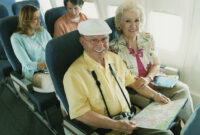Travel for singles over 60 represents a vibrant opportunity for exploration and personal growth. This guide delves into the planning, logistics, and considerations unique to solo travel in this age group, offering insights into destination choices, safety measures, social connections, and practical advice for a fulfilling and enriching experience. We’ll explore everything from choosing accessible destinations to managing health concerns while on the road, ensuring a smooth and enjoyable journey for every adventurous spirit.
Whether you envision a relaxing beach vacation or an exciting cultural immersion, this resource aims to empower you to confidently plan and execute the solo trip of your dreams. We’ll cover practical tips on budgeting, accommodation choices, and staying connected, making your journey as stress-free as possible. The focus is on making solo travel accessible, safe, and ultimately, a truly rewarding experience.
Destinations Ideal for Solo Travelers Over 60
Planning a solo trip after 60 offers a unique opportunity for self-discovery and relaxation. Choosing the right destination is key to ensuring a comfortable and enriching experience. Factors like ease of navigation, accessibility, and cultural richness should be carefully considered. This section will highlight destinations particularly well-suited for solo travelers in this age group.
Five Destinations for Solo Travelers Over 60
Several destinations stand out for their accessibility and welcoming atmosphere for solo travelers over 60. These locations offer a blend of cultural immersion, manageable exploration, and opportunities for relaxation.
Here are five ideal destinations:
- San Sebastian, Spain: This beautiful coastal city boasts excellent public transportation, making it easy to navigate. The charming Old Town is pedestrian-friendly, and the city offers a rich culinary scene, renowned for its pintxos (Basque tapas). The slower pace of life compared to larger cities makes it ideal for relaxed exploration.
- Quebec City, Canada: Quebec City’s historic Old Town is easily walkable, with cobblestone streets and charming architecture. The city’s French-Canadian culture is captivating, offering a unique immersion experience. The city is also accessible by public transport, making it convenient for independent exploration.
- Kyoto, Japan: While Japan might seem daunting, Kyoto offers a gentler introduction to Japanese culture. The city has excellent public transport, including a well-maintained subway system. Temples, gardens, and traditional tea houses offer a rich cultural experience, and the city is renowned for its calm atmosphere.
- Florence, Italy: Florence, while bustling, is remarkably walkable, especially the historic center. Its Renaissance art and architecture are captivating, and the city offers numerous opportunities for leisurely exploration. While some hills may present a slight challenge, the accessibility of many sites and the availability of taxis make it manageable.
- Charleston, South Carolina, USA: Charleston’s historic district is easily walkable, with many attractions within close proximity. The city offers a blend of Southern charm, history, and culinary delights. Its relatively flat terrain makes it comfortable for walking, and the city’s well-maintained sidewalks and accessibility features cater to a range of mobility levels.
Comparing and Contrasting Two Destinations
Let’s compare San Sebastian, Spain, and Kyoto, Japan, to illustrate how destinations cater to different travel styles.
San Sebastian offers a more relaxed pace, ideal for those seeking culinary experiences and leisurely exploration. Its coastal location provides opportunities for walks along the beach and enjoying the fresh sea air. Kyoto, on the other hand, provides a deeper immersion into a different culture, but may require more planning and a willingness to navigate a more complex public transportation system. While both offer cultural richness, San Sebastian caters to a more relaxed travel style, while Kyoto might be better suited for a more adventurous and culturally immersive trip.
Destinations for Solo Travelers Over 60: A Comparison
| Destination | Accessibility Features | Cultural Highlights | Recommended Activities |
|---|---|---|---|
| San Sebastian, Spain | Excellent public transport, pedestrian-friendly Old Town, relatively flat terrain | Basque culture, pintxos (tapas), beautiful beaches | Exploring the Old Town, enjoying pintxos, relaxing on the beach, visiting the Monte Urgull |
| Quebec City, Canada | Walkable Old Town, good public transport, accessible attractions | French-Canadian culture, historic architecture, charming streets | Exploring the Old Town, visiting the Citadelle, enjoying the local cuisine, taking a horse-drawn carriage ride |
| Kyoto, Japan | Efficient public transport (subway, buses), well-maintained walkways | Temples, gardens, traditional tea ceremonies, geisha district | Visiting temples and shrines, exploring traditional gardens, attending a tea ceremony, wandering through Gion |
| Florence, Italy | Walkable historic center, taxis readily available, accessible attractions | Renaissance art and architecture, delicious food, stunning views | Visiting the Uffizi Gallery, climbing to the top of Duomo, exploring the Ponte Vecchio, enjoying gelato |
Social Aspects of Solo Travel for Seniors
Embarking on solo travel adventures after 60 offers incredible opportunities for personal growth and discovery, but it’s also crucial to consider the social aspect. Loneliness can be a concern for some, but with a proactive approach, solo travel can become a fantastic way to meet new people and build lasting connections. This section explores strategies for fostering social interaction and combating potential isolation during senior solo trips.
Connecting with Others During Solo Travel
Many opportunities exist for seniors traveling alone to connect with others. Active participation is key. Joining group tours or activities specifically designed for solo travelers is an excellent starting point. These curated experiences offer built-in social interaction, removing the pressure of initiating conversations in unfamiliar settings. Furthermore, utilizing social media groups dedicated to solo travel or travel in specific destinations can help connect with like-minded individuals before, during, and after a trip. Participating in local events and activities—from cooking classes to walking tours—provides chances to meet people with shared interests. Staying in accommodations with communal spaces, like hostels or guesthouses (though less common for seniors, some offer private rooms with shared social areas), can also encourage interaction.
Examples of Group Tours and Activities for Single Travelers
Several companies specialize in group tours and activities designed for single travelers over 60. For instance, a company might offer a guided walking tour of historical sites in Rome, specifically marketed towards solo travelers in the 60+ age bracket. The itinerary might include not only the historical aspects but also scheduled meals and social events where participants can interact. Another example could be a cruise designed for mature solo travelers, featuring themed parties, onboard lectures, and group excursions, all aimed at encouraging socialization. Adventure travel companies may offer hiking or cycling tours catered to active seniors traveling alone, incorporating opportunities for group bonding through shared experiences. These examples demonstrate how structured activities facilitate social interaction.
Tips for Striking Up Conversations and Making New Friends
Initiating conversations can feel daunting, but a few simple techniques can ease the process. A genuine compliment, such as “I love your scarf; where did you get it?” can be a natural conversation starter. Asking open-ended questions, like “What brought you to this beautiful place?” shows interest and encourages a response beyond a simple “yes” or “no.” Joining a group activity or tour provides a shared experience that serves as a conversation springboard. Participating in conversations already happening, even briefly, is another approach. Remember, a smile and friendly demeanor go a long way in creating a welcoming atmosphere. Showing genuine interest in others and actively listening are key to building connections. Don’t be afraid to share a little about yourself; vulnerability can foster genuine connections.
Last Point
Embarking on a solo adventure after 60 offers unparalleled freedom and the chance to rediscover yourself. This guide has provided a framework for planning a safe, enriching, and enjoyable trip, addressing practical concerns while emphasizing the social and personal rewards of solo travel. Remember to prioritize your well-being, embrace the unexpected, and cherish the memories you create. The world awaits, and your journey is waiting to begin.




